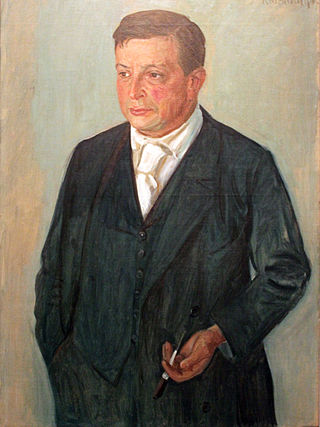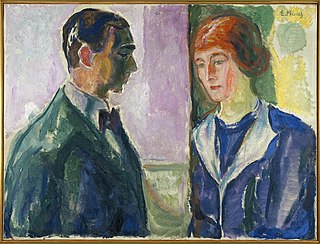Related Research Articles

Lucas Cranach the Elder was a German Renaissance painter and printmaker in woodcut and engraving. He was court painter to the Electors of Saxony for most of his career, and is known for his portraits, both of German princes and those of the leaders of the Protestant Reformation, whose cause he embraced with enthusiasm. He was a close friend of Martin Luther. Cranach also painted religious subjects, first in the Catholic tradition, and later trying to find new ways of conveying Lutheran religious concerns in art. He continued throughout his career to paint nude subjects drawn from mythology and religion.

Paul Cassirer was a German art dealer and editor who played a significant role in the promotion of the work of artists of the Berlin Secession and of French Impressionists and Post-Impressionists, in particular that of Vincent van Gogh and Paul Cézanne.

Carl Eduard Ferdinand Blechen was a German landscape painter and a professor at the Academy of Arts, Berlin. His distinctive style was characteristic of the Romantic ideals of natural beauty.

Le Bassin Aux Nymphéas is one of the series of Water Lilies paintings by French impressionist artist Claude Monet.

Hugo Perls (24 May 1886–1977 was an international art dealer, historian, philosopher and notable collector born in Rybnik in Upper Silesia. During his lifetime, he witnessed his homeland change from its German origins to Polish. He studied law, philosophy, and art history at the University of Freiburg and in Berlin. On completion of his studies he joined the German civil service and worked for the Ministry of the Interior prior to serving in the German Foreign Office during World War I. Perls married his first wife Kaethe in 1910.

Frances Lasker Brody (1916–2009) was an American arts advocate, collector, and philanthropist who influenced the development of Los Angeles' cultural life as a founding benefactor of the Los Angeles County Museum of Art and later as a guiding patron of the Huntington Library, Art Collections and Gardens.
Frank Richard Perls was a German-born American art dealer who was best known for uncovering a series of fraudulent art works. As an interpreter with the United States Third Army, Perls worked together with Army intelligence officer Martin Dannenberg in April 1945 in the discovery of a copy of the 1935 Nuremberg Laws signed by Adolf Hitler.

M. Knoedler & Co. was an art dealership in New York City founded in 1846. When it closed in 2011, amid lawsuits for fraud, it was one of the oldest commercial art galleries in the US, having been in operation for 165 years.
Eugene Victor Thaw was an American art dealer and collector. He was the owner of an art gallery on Madison Avenue in Manhattan, and a past president of the Art Dealers Association of America. With his wife, Clare, he donated over 1,000 works of art to the Fenimore Art Museum and the Morgan Library & Museum.
Rudolph J. Heinemann, also known as Rudolf J. Heinemann, was a German-born American art dealer and collector of Old Masters. He was an advisor to Baron Hans Heinrich Thyssen-Bornemisza, who established a museum in Lugano, Switzerland with his help. Heinemann and later, his wife Lore, donated works of art to the Metropolitan Museum of Art, the Frick Collection, the National Gallery of Art and the Morgan Library & Museum.

Leo Bendel was a tobacco dealer and art collector.

Leo Lewin was a German merchant, art collector and horse breeder who was persecuted by the Nazis due to being Jewish.
Michael Berolzheimer was a German entrepreneur, lawyer and art collector.
Richard Semmel was a German entrepreneur and art collector who was persecuted by the Nazis because of his Jewish heritage. His heirs have filed restitution claims for artworks.

Paul Graupe was a German antiquarian bookseller and art dealer.
Heinz Kisters was a German entrepreneur, art dealer and art collector.
Gustav Kirstein was a German publisher, writer, and art collector of Jewish descent.

Margarete Oppenheim was a German art collector and patron. She was among the first personalities to collect works of modern art in Germany and owned one of the largest collection in Germany.
Hedwig Frida Ullmann, née Nathan, was a German Jewish art collector and refugee.
References
- ↑ "Sammlung Eisenmann | Proveana". www.proveana.de. Retrieved 2022-02-16.
- ↑ "Margarete Eisenmann". geni_family_tree. 19 February 1867. Retrieved 2022-02-14.
- ↑ "CRANACH DIGITAL ARCHIVE". lucascranach.org. Retrieved 2022-02-14.
- with Rudolf Weigel, Leipzig. [Schuchardt 1871 C, no. 342] - (Possibly) Hofrath Keil, Leipzig. - Raphael Eisenmann (c. 1821-?), Berlin, and by descent to - Margarete Eisenmann (1868-1942), Berlin, by whom sold under duress to the Reichskanzlei, Berlin, as partial payment of discriminatory taxes, after November 1938. - H. W. Lange; Sotheby's, London, 23 March 1949, lot 102 (£700 to Drown). with Hugo Perls, New York. - with Knoedler, New York, acquired from the above, 5 May 1954 (inv. no. A5708) and jointly owned with Rudolf Heinemann, New York. - with Rudolf Heinemann, New York, acquired from the above, 28 November 1968, and from whom acquired by the present owner. - Christie's, New York, 22.04.2021, lot 12 [Christie's online database, accessed 20.04.2021] (www.christies.com/lot/lot-lucas-cranach-i-kronach-1472-1553-weimar-the-6313040)
- ↑ "Kunstsammlung und Wohnungseinrichtung Generalkonsul Eisenmann + Berlin". buchfreund.de.
Mit 31 Tafelseiten. 50 S., 1 Bl. Gutes, sauberes Exemplar dieses 1072 Positionen umfassenden Auktionskataloges mit dem Nachlass des portugiesischen Generalkonsuls Raphael Eisenman
- 1 2 3 4 5 Villa, Angelica (2021-04-16). "Cranach Painting Sold Under Duress During World War II to Be Auctioned as Part of Legal Settlement". ARTnews.com. Retrieved 2022-02-14.
- ↑ Ahn, Cabelle (2021-05-18). "Old Masters Today #3". ars longa. Retrieved 2022-02-16.
A Lucas Cranach the Elder painting was sold on April 22 at Christie's as part of a legal settlement between the estate of Eugene V. Thaw and the heirs of Margarete Eisenmann. The Cranach was sold by the Eisenmann family under duress as payment of an antisemitic WWII tax system known as Judenvermögensabgabe.
- ↑ "CRANACH DIGITAL ARCHIVE". lucascranach.org. Archived from the original on 2022-02-14. Retrieved 2022-02-20.
Provenance. - with Rudolf Weigel, Leipzig. [Schuchardt 1871 C, no. 342] - (Possibly) Hofrath Keil, Leipzig. - Raphael Eisenmann (c. 1821-?), Berlin, and by descent to - Margarete Eisenmann (1868-1942), Berlin, by whom sold under duress to the Reichskanzlei, Berlin, as partial payment of discriminatory taxes, after November 1938. - H. W. Lange; Sotheby's, London, 23 March 1949, lot 102 (£700 to Drown). with Hugo Perls, New York. - with Knoedler, New York, acquired from the above, 5 May 1954 (inv. no. A5708) and jointly owned with Rudolf Heinemann, New York. - with Rudolf Heinemann, New York, acquired from the above, 28 November 1968, and from whom acquired by the present owner. - Christie's, New York, 22.04.2021, lot 12
- ↑ Rudolph Lepke's Kunst-Auctions-Haus (Berlin) (1935). Kunstsammlung und Wohnungseinrichtung Generalkonsul Eisenmann +, Berlin: Versteigerung 19.-20. Juni 1935 (in German). Berlin. OCLC 888585922.
{{cite book}}: CS1 maint: location missing publisher (link) - ↑ Rudolph Lepke's Kunst-Auctions-Haus (1935). Kunstsammlung und Wohnungseinrichtung Generalkonsul Eisenmann (in German). Berlin. OCLC 171386933.
{{cite book}}: CS1 maint: location missing publisher (link) - ↑ "Backlash over return of looted art". the Guardian. 2006-12-10. Archived from the original on 2013-08-30. Retrieved 2022-02-14.
- ↑ "LUCAS CRANACH I (KRONACH 1472-1553 WEIMAR)". www.christies.com. Archived from the original on 2022-02-14. Retrieved 2022-02-14.
Please note that the present work is being offered for sale pursuant to a settlement agreement between the current owner and the heir of Margarete Eisenmann. The settlement agreement resolves the dispute over ownership of the work and title will pass to the successful bidder.
- ↑ Ahn, Cabelle (2021-05-18). "Old Masters Today #3". ars longa. Retrieved 2022-02-14.